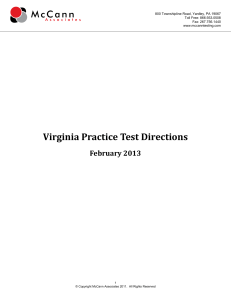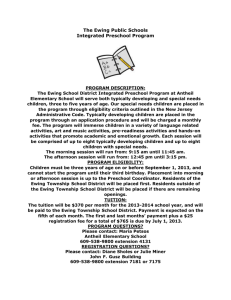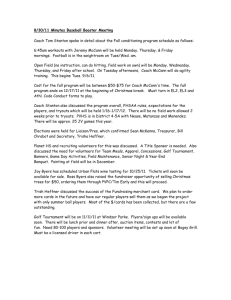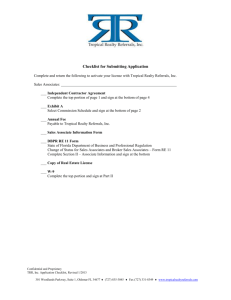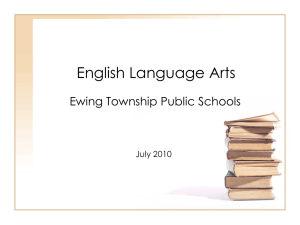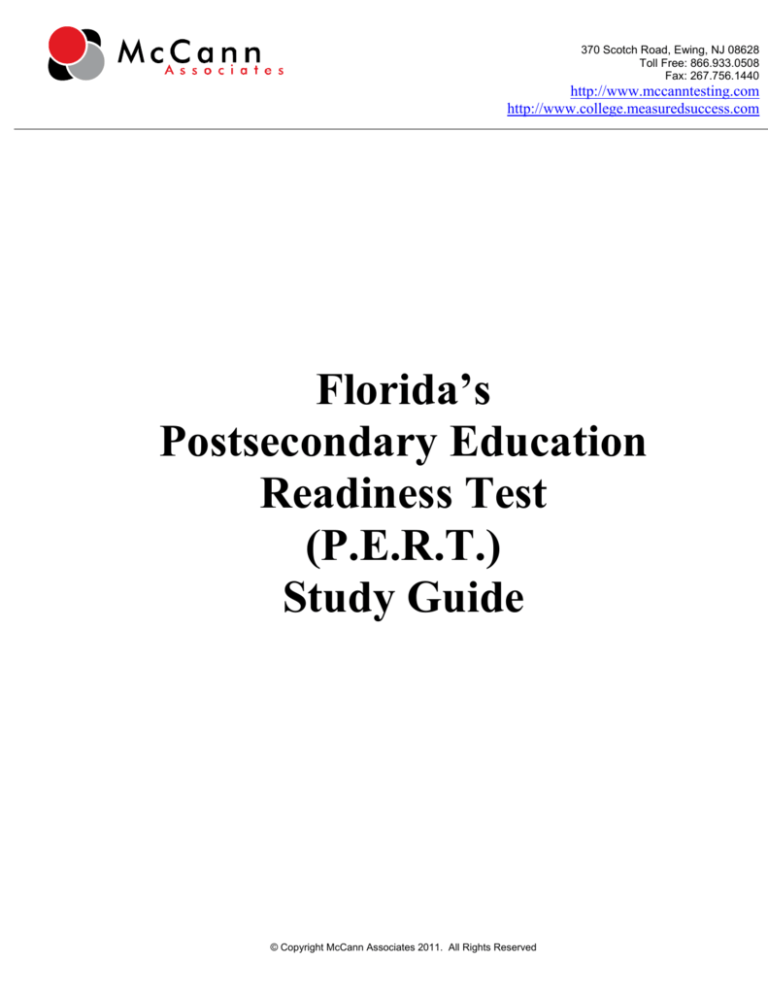
370 Scotch Road, Ewing, NJ 08628
Toll Free: 866.933.0508
Fax: 267.756.1440
http://www.mccanntesting.com
http://www.college.measuredsuccess.com
Florida’s Postsecondary Education Readiness Test (P.E.R.T.) Study Guide
© Copyright McCann Associates 2011. All Rights Reserved
370 Scotch Road, Ewing, NJ 08628
Toll Free: 866.933.0508
Fax: 267.756.1440
http://www.mccanntesting.com
http://www.college.measuredsuccess.com
Introduction
The purpose of Florida’s Postsecondary Education Readiness Test (P.E.R.T.) is to
adequately assess your academic skills in mathematics, reading and writing through the
delivery of three assessments, one for each of these areas. The results of these assessments
are used to determine your placement into appropriate courses at your college.
You cannot pass or fail the P.E.R.T. – it is only used to determine which courses are best
for you. While it doesn’t impact your grades, we encourage you to take the P.E.R.T.
seriously so that your course placement is accurate.
How the P.E.R.T. Works
The P.E.R.T. assessments are computer-adaptive, which means the questions are chosen
based on your answers to previous questions. You will not be permitted to change your
answer once you have moved on to the next question or leave a question unanswered.
However, all of the P.E.R.T. assessments are untimed so you have as much time as you
need to consider each question before submitting your answer. If you do not know the
answer to a specific question, you are encouraged to try and answer the question by
eliminating one or more of the answer options and then select from the remaining choices.
You will not be allowed to bring a calculator with you; however, for certain questions, a
pop-up calculator will be available for your use. Check with your college testing center for
what to bring or not to bring with you on test day.
Your scores on each assessment will be available immediately after you submit and your
college will provide you with the results.
Test Taking Tips
Prepare
Take practice assessments and study areas of weakness.
Read the directions carefully
When you take the assessments, make sure to take your time and carefully follow
the instructions for each question.
Use reasoning when answering
1. Identify the key phrase in the question.
2. Try to find the correct answer before you read all the choices.
3. Eliminate the choices that you know are not correct.
4. Read all the choices and pick the best answer.
2
© Copyright McCann Associates 2011. All Rights Reserved
370 Scotch Road, Ewing, NJ 08628
Toll Free: 866.933.0508
Fax: 267.756.1440
http://www.mccanntesting.com
http://www.college.measuredsuccess.com
Review
Be sure to review each answer carefully before submitting. You will not be able to
go back to any questions.
P.E.R.T. Subject Area Assessments
There are three P.E.R.T. assessments, each with 30 questions. The content that is tested is
listed below by subject:
Mathematics:
Equations – solving linear equations, linear inequalities, quadratic equations and
literal equations
Evaluating algebraic expressions
Polynomials – factoring, simplifying, adding, subtracting, multiplying and dividing
Dividing by monomials and binomials
Applying standard algorithms or concepts
Coordinate planes – translating between lines and inspect equations
Focusing on pairs of simultaneous linear equations in two variables
Reading:
Discerning and summarizing the most important ideas, events, or information
Supporting or challenging assertions about the text
Determining the meaning of words and phrases in context
Analyzing the meaning, word choices, tone and organizational structure of the text
Determining the author’s purpose and the relation of events in the text to one
another
Recognizing relationships within and between sentences
Analyzing the traits, motivations and thoughts of individuals in fiction and
nonfiction
Analyzing how two or more texts with different styles, points of view or arguments
address similar topics or themes
Distinguishing between facts and opinions
Evaluating reasoning and rhetoric of an argument or explanation
Writing:
Sustaining focus on a specific topic or argument
Establishing a topic or thesis
3
© Copyright McCann Associates 2011. All Rights Reserved
370 Scotch Road, Ewing, NJ 08628
Toll Free: 866.933.0508
Fax: 267.756.1440
http://www.mccanntesting.com
http://www.college.measuredsuccess.com
Demonstrating use of the conventions of standard written English, including
grammar, usage and mechanics
Supporting and illustrating arguments and explanations
Developing and maintaining a style and tone
Synthesizing information from multiple relevant sources
Conveying complex information clearly and coherently
Representing and accurately citing data, conclusions, and opinions of others
Establishing a substantive claim and acknowledging competing arguments or
information
Conceptual and Organizational Skills – recognizing effective transitional devices
within the context of a passage
Word Choice Skills – recognizing commonly confused or misused words and
phrases
Sentence Structure Skills – using modifiers correctly; using coordination and
subordination effectively; and recognizing parallel structure
Grammar, Spelling, Capitalization and Punctuation Skills - avoiding inappropriate
shifts in verb tense and pronouns; maintaining agreement between pronoun and
antecedent; and using proper case forms, adjectives and adverbs
What should you expect?
The following section provides an overview of the type of information you will need to
know to perform well on the subject area assessments but it is not intended to be a
comprehensive listing of all content to be tested.
4
© Copyright McCann Associates 2011. All Rights Reserved
370 Scotch Road, Ewing, NJ 08628
Toll Free: 866.933.0508
Fax: 267.756.1440
http://www.mccanntesting.com
http://www.college.measuredsuccess.com
Mathematics:
You should review your basic math rules such as, the order of operations, exponents, prime
numbers and percents. Here are a few of the rules to review:
Order of Operations
work within parentheses simplify exponents multiplication and division addition and subtraction Exponents
The mathematical notation that notates a variable is multiplied by itself the number of
times indicated by the exponent. x3 = x × x × x x5 = x × x × x × x × x Prime Numbers
A prime number is defined as an integer that is greater than 1, and has only two positive
factors, 1 and itself. The first ten prime numbers are 2, 3, 5, 7, 11, 13, 17, 19, 23, and 29.
Percents
The word percent means “hundredths” or a number which is divided by 100. Converting a
number into a percentage involves multiplying the number by 100.
A percent can be determined by performing the division of the part by the total and multiplying it by 100: Percent = Part ×100 Total
5
© Copyright McCann Associates 2011. All Rights Reserved
370 Scotch Road, Ewing, NJ 08628
Toll Free: 866.933.0508
Fax: 267.756.1440
http://www.mccanntesting.com
http://www.college.measuredsuccess.com
Math Sample Questions:
1. Which of the following is a solution to the equation c + (4 – 3c) – 2 = 0?
A.
B.
C.
D.
-1
0
1
2
2. Graph the solution of y – 2 > 1 on a number line.
A.
B.
C.
D.
-10
-5
0
5
10
-10
-5
0
5
10
-10
-5
0
5
10
-10
-5
0
5
10
3. Which of the following is a solution to the equation x2 – 6x + 5 = 0?
A. x = -5
B. x = -1
C. x =
D. x = 5
4. What is the value of the algebraic expression if x =
, y = -1, and z = 2?
6x(y2z)
A. -12
B. -6
C.
1
D.
6
6
© Copyright McCann Associates 2011. All Rights Reserved
370 Scotch Road, Ewing, NJ 08628
Toll Free: 866.933.0508
Fax: 267.756.1440
http://www.mccanntesting.com
http://www.college.measuredsuccess.com
7
© Copyright McCann Associates 2011. All Rights Reserved
370 Scotch Road, Ewing, NJ 08628
Toll Free: 866.933.0508
Fax: 267.756.1440
http://www.mccanntesting.com
http://www.college.measuredsuccess.com
5. Which of the following is equivalent to (8 – 5) ÷ 23 ?
A.
B.
C.
D.
6. Factor completely:
x2 – x – 6?
A.
B.
C.
D.
(x – 2)(x + 3)
(x – 1)(x – 6)
(x + 2)(x – 3)
(x + 1)(x – 6)
7. Simplify the following expression:
3x4y2
2
xy
A.
B.
C.
D.
8. Which of the following is equivalent to the expression (3ab)(-5ab)?
A. -2ab
B. -2a2b2
C. -15ab
D. -15a2b2
8
© Copyright McCann Associates 2011. All Rights Reserved
370 Scotch Road, Ewing, NJ 08628
Toll Free: 866.933.0508
Fax: 267.756.1440
http://www.mccanntesting.com
http://www.college.measuredsuccess.com
9
© Copyright McCann Associates 2011. All Rights Reserved
370 Scotch Road, Ewing, NJ 08628
Toll Free: 866.933.0508
Fax: 267.756.1440
http://www.mccanntesting.com
http://www.college.measuredsuccess.com
9. What percent of the grid is shaded?
A.
B.
C.
D.
35%
40%
45%
55%
10. Which of the following is the equation of a line that passes through (-2, -1) and (-4, -3)?
A. y =
x+1
B. y = x + 1
C. y =
x–1
D. y = x – 1
10
© Copyright McCann Associates 2011. All Rights Reserved
370 Scotch Road, Ewing, NJ 08628
Toll Free: 866.933.0508
Fax: 267.756.1440
http://www.mccanntesting.com
http://www.college.measuredsuccess.com
Reading:
Read each passage carefully. Since the assessment is not timed, take as much time as you
need to read each passage. Each passage may have one or more questions.
A helpful strategy is to focus on the opening and ending sentences of each paragraph to
identify the main idea. Another strategy is to look for key words or phrases within the
passage that indicate the author’s purpose or the meaning.
Reading Sample Questions:
Read the selection and answer the questions that follow.
A Born Artist
Benjamin West was born in a small town near Philadelphia, Pennsylvania, in 1738.
Soon after Benjamin's birth, the family minister paid a visit. "This boy will do great
things someday," the minister said. The minister's words left the Wests wondering what
might be in store for their son. Then, when Benjamin was seven years old, he drew a
picture of his baby niece. Benjamin's parents were stunned to see how skilled his
drawing was. Perhaps it is a sign, they thought.
As he grew up, Benjamin drew whenever he could. He especially liked drawing
animals he saw in the fields and woods near his house. One day, as Benjamin was
drawing a robin, three Lenape Indians passed by. They looked at the drawing and, in
their own language, discussed what was wrong with it. Finally, one of the Lenape told
Benjamin in English that the robin's breast should be red. When Benjamin explained
that he didn't have any paint, the Lenapes dug some red and yellow clay from the
riverbank and showed him how to make paint from the clay.
Benjamin ran home with his red and yellow paints. When his mother saw how
excited he was, she gave him some blue indigo, which she used to dye wool. Now
Benjamin had the three primary colors, which he could mix to make other paint colors.
But Benjamin still needed a brush. There was no place around to buy one, so Benjamin
decided to make his own. When his parents weren't looking, he snipped some hair from
his cat's tail. Then he pressed the hairs to the tip of a goose quill and wound yarn
around the tip to secure the hairs.
The brush worked, but not for long. After it fell apart, Benjamin made more. Soon
Mr. and Mrs. West saw that the family cat was missing great patches of fur. At first
they were furious, but then they softened. They knew that a boy who would go to such
lengths to paint must be special. So they bought Benjamin paints, brushes, and some
canvas.
11
© Copyright McCann Associates 2011. All Rights Reserved
370 Scotch Road, Ewing, NJ 08628
Toll Free: 866.933.0508
Fax: 267.756.1440
http://www.mccanntesting.com
http://www.college.measuredsuccess.com
From these beginnings, Benjamin West became a great and famous painter. In 1763
he moved to England and never returned to America. Although he taught himself to
paint, he was happy to teach younger artists, especially ones who traveled from the
United States to study with him. For this reason, West is often called the father of
American art.
1. Which of the following statements is the best summary of this selection?
A. Benjamin West drew pictures of his niece and a robin. Then, he became interested
in painting instead.
B. As a young child, Benjamin West loved to draw and paint. He grew up to become a
great and famous painter.
C. Benjamin West taught himself to draw. Then some Indian friends and his parents
gave him painting supplies.
D. A minister predicted that Benjamin West would do great things someday. His
parents soon discovered that Benjamin was special.
2. How is the information in this selection organized?
A.
B.
C.
D.
In chronological order
As a list of problems and solutions
In a series of questions and answers
From least important to most important
3. As it is used in this selection, the word secure means —
A.
B.
C.
D.
free from danger.
to take or get.
sure or certain.
to fasten or hold tight.
4. The author’s main purpose in writing this selection was to —
A.
B.
C.
D.
persuade young artists to keep drawing.
show that art supplies can be made from everyday things.
entertain with a story about a young artist.
inform readers about art long ago.
12
© Copyright McCann Associates 2011. All Rights Reserved
370 Scotch Road, Ewing, NJ 08628
Toll Free: 866.933.0508
Fax: 267.756.1440
http://www.mccanntesting.com
http://www.college.measuredsuccess.com
Read the selection and answer the questions that follow.
King of the Sea
Thor Heyerdahl, a famous adventurer from Norway, could not swim. He nearly
drowned more than once when he was a teenager. For a long time he was afraid of
water. It's surprising, then, to learn that he spent much of his life sailing delicate boats
on the world's oceans.
In 1947, Heyerdahl set off on his first great adventure. He hoped to cross the Pacific
Ocean from South America to Polynesia. Heyerdahl thought that early people might
have migrated to Polynesia thousands of years ago by sea. He reasoned that if he could
follow this route in a simple raft, he would show it was possible.
Heyerdahl constructed a raft of balsa wood and set out to cross the Pacific Ocean.
This wood is so light that today it is used for model airplanes. Critics thought the raft
would get waterlogged and sink, but they were wrong. The raft, called the Kon-Tiki,
landed in Polynesia after about 100 days at sea.
On another trip, in 1969, Heyerdahl tried to sail across the Atlantic Ocean from
North Africa to the Caribbean. His first boat for this trip was the Ra; it was made of
reeds. The design was based on ancient drawings found on a wall in Egypt. After the
Ra broke apart, Heyerdahl did not give up. A year later, he set off in a new boat, called
the Ra II, and made the 3200-mile trip successfully.
The Norwegian explorer became well known through the books he wrote about his
adventures at sea. His book about the voyage in the Kon-Tiki sold 25 million copies.
Heyerdahl believed that his voyages proved his theory that peoples of long ago
sailed to distant places. This could explain why similar cultures have shown up in
places that were far removed from each other. For example, it could explain why
pyramids are found both in Egypt and in Mexico, even though these countries are on
opposite sides of the world.
Today, experts don't generally accept Heyerdahl's voyages as proof of his theories.
Still, he is viewed as a remarkable sea-going explorer, and that's not bad for a boy who
was once afraid of the water.
5. Which evidence in this selection best supports the theory that people migrated across
the Atlantic Ocean thousands of years ago?
A.
B.
C.
D.
Heyerdahl made a raft of balsa wood found in South America.
The Ra was based on a design from a drawing found in Egypt.
Heyerdahl made a boat of reeds, but it broke apart.
Ancient pyramids have been found in both Mexico and Egypt.
13
© Copyright McCann Associates 2011. All Rights Reserved
370 Scotch Road, Ewing, NJ 08628
Toll Free: 866.933.0508
Fax: 267.756.1440
http://www.mccanntesting.com
http://www.college.measuredsuccess.com
6. In what way were the two voyages described in this selection alike?
A.
B.
C.
D.
Heyerdahl used the same boat for both voyages.
Heyerdahl was trying to prove the same theory on both voyages.
Both voyages followed the same route.
Both voyages succeeded on the first attempt.
7. According to this passage, the purpose of Heyerdahl's first voyage in 1947 was to —
A.
B.
C.
D.
sail across the Atlantic Ocean in a reed boat.
prove you can become famous by sailing long distances.
learn how to build a simple raft of balsa wood.
show that the Polynesians could have crossed the Pacific Ocean.
Read the selection and answer the questions that follow.
Sacajawea Saves the Day
The baby squirmed in his basket, and Sacajawea hummed quietly to soothe him. At
three months old, he was a strong, healthy child and was already used to life in the
wilderness. The young mother knew the little boy would soon fall into a peaceful sleep,
lulled by the rocking motion of the river. Sacajawea closed her eyes and rested. She
carried little Pompy on her back night and day, yet she never failed to keep up with her
companions. Under the leadership of Lewis and Clark, she and a large band of men
were on a great journey to explore the western wilderness.
For now, things were going well. Just that morning Sacajawea had found an
abundant supply of edible roots—enough to satisfy the hunger of all the men in the
group. Captain Clark had praised her warmly and recorded the event in his journal. The
men, at first suspicious of the Shoshone woman with the child, now welcomed her as an
important member of the group.
Sacajawea dozed quietly until a sudden clap of thunder awakened her. Rain began
to fall, and a sudden strong wind nearly knocked her over. The boat tipped. Bundles of
supplies slid toward the water. Suddenly the boat overturned, and Sacajawea fell into
the river. She struggled to keep Pompy's head above the rushing water. Captain Clark
shouted; another man screamed. Sacajawea reached for her son, strapped in the basket
on her back. A wail told her that he was fine, though cold and wet.
The water was not deep, but the current was strong. The men worked frantically to
right the overturned boat. No one but Sacajawea noticed the bundles bobbing in the
water. As they spun farther away from the boat, Sacajawea grabbed an overhanging
14
© Copyright McCann Associates 2011. All Rights Reserved
370 Scotch Road, Ewing, NJ 08628
Toll Free: 866.933.0508
Fax: 267.756.1440
http://www.mccanntesting.com
http://www.college.measuredsuccess.com
branch, and quickly lowered the branch to trap the bundles. When the boat was finally
right-side up, Sacajawea quietly placed the precious bundles inside.
15
© Copyright McCann Associates 2011. All Rights Reserved
370 Scotch Road, Ewing, NJ 08628
Toll Free: 866.933.0508
Fax: 267.756.1440
http://www.mccanntesting.com
http://www.college.measuredsuccess.com
8. Where does this story take place?
A.
B.
C.
D.
In Sacajawea's village
On a river in the wilderness
In a mountain pass
At a fort on the frontier
9. The writer of this selection seems to view Sacajawea with a feeling of —
A.
B.
C.
D.
admiration.
amusement.
dislike.
confusion.
10. Which of the following is the best description of the theme of this selection?
A.
B.
C.
D.
Only the strong survive.
A penny saved is a penny earned.
One person can make a difference.
Practice makes perfect.
16
© Copyright McCann Associates 2011. All Rights Reserved
370 Scotch Road, Ewing, NJ 08628
Toll Free: 866.933.0508
Fax: 267.756.1440
http://www.mccanntesting.com
http://www.college.measuredsuccess.com
Writing:
Review basic writing rules such as errors in word choice, punctuation and capitalization.
You may want to look over materials on when and how apostrophes and commas should be
used as well as reviewing common sentence structure errors.
Writing Sample Questions:
Read the selection about American astronaut Sally Ride and answer the question.
(1) Some of the greatest success stories in American history began with failure. (2) Take
the case of Sally Ride. (3) When Ride was a young girl in Encino, California, her goal
was to become a professional tennis player. (4) She dropped out of college and practiced
hard to become a tennis pro. (5) In time, she realized that she would never be good
enough to compete with the best tennis players. (6) She returned to college and studied
astrophysics.
(7) One day in 1977, while working on her Ph.D. at Stanford University, Ride read that
NASA was looking for astronauts. (8) She applied and was one of six women accepted
into the space program. (9) Ride trained to be an astronaut longer and harder than she
had ever done anything in her life. (10) By the early 1980s, she was part of the space
shuttle program. (11) In 1983, as a member of the crew of the space shuttle Challenger,
Sally Ride became the first American woman to journey into space.
(12) Ride was getting ready for another mission when the Challenger exploded in 1986,
killing the whole crew. (13) One of them was a New Hampshire high school teacher
named Christa McAuliffe. (14) Ride was appointed to a special commission that
investigated the tragic accident. (15) A year later she retired from NASA and returned to
California, where she taught college. (16) Since then, she has been involved in several
organizations that encourage girls who are interested in science and math.
1. Which sentence does NOT belong in the selection?
A.
B.
C.
D.
Sentence 4
Sentence 6
Sentence 13
Sentence 15
17
© Copyright McCann Associates 2011. All Rights Reserved
370 Scotch Road, Ewing, NJ 08628
Toll Free: 866.933.0508
Fax: 267.756.1440
http://www.mccanntesting.com
http://www.college.measuredsuccess.com
2. Choose the word that best completes the sentence.
Harold’s grandmother entertained the families with stories ______ growing up in
Africa, explaining the many differences between her life now and her life back then.
A.
B.
C.
D.
about
within
between
throughout
3. Choose the sentences that best support the following topic sentence:
Hay fever is the common name for an allergic reaction to pollen.
A. In my father's family, allergies are quite common. His sister Jane is allergic to dust,
pollen, and mold, as well as foods such as tomatoes and eggplant.
B. It seems that allergic reactions to peanuts and tree nuts are becoming more and
more common, too. Many schools have recently banned peanuts and peanut butter
altogether.
C. People who suffer from allergies can check the weather report in the newspaper for
the allergen counts. The weather page also includes interesting information about
the phases of the moon and the times of sunrise and sunset.
D. The worst offender is ragweed pollen, which causes many people to suffer from
sneezing, runny nose, and itchy eyes from late summer to late fall. Dust and animal
dander may also bring on the symptoms of hay fever.
4. Choose the best order of the sentences in the paragraph.
A. Before long, the storm moved on, and all was quiet again. From my window, I
watched bright lightning bolts streak across the sky. After each lightning flash, the
thunder boomed loudly. Last night a powerful thunderstorm rolled through our
town.
B. From my window, I watched bright lightning bolts streak across the sky. Last night
a powerful thunderstorm rolled through our town. Before long, the storm moved on,
and all was quiet again. After each lightning flash, the thunder boomed loudly.
C. Last night a powerful thunderstorm rolled through our town. From my window, I
watched bright lightning bolts streak across the sky. After each lightning flash, the
thunder boomed loudly. Before long, the storm moved on, and all was quiet again.
D. After each lightning flash, the thunder boomed loudly. Before long, the storm
moved on, and all was quiet again. Last night a powerful thunderstorm rolled
18
© Copyright McCann Associates 2011. All Rights Reserved
370 Scotch Road, Ewing, NJ 08628
Toll Free: 866.933.0508
Fax: 267.756.1440
http://www.mccanntesting.com
http://www.college.measuredsuccess.com
through our town. From my window, I watched bright lightning bolts streak across
the sky.
5. Choose the sentence that is written correctly.
A. Roasted with garlic, Abby decided to order the potatoes with dinner.
B. Abby decided to order the roasted garlic potatoes with dinner.
C. Deciding to order with dinner, the roasted garlic potatoes were what Abby decided
on.
D. Ordered with dinner, Abby decided on the roasted garlic potatoes.
6. In researching granite, a research paper is located that includes the following
information:
Granite is a hard, coarse rock. It is formed by the slow cooling of magma under the
earth's surface. The main minerals in granite are quartz and feldspar. It contains smaller
amounts of mica and hornblende.
Granite's hardness makes it a popular building stone. It can be polished to a shiny finish
and will stand up to centuries of weathering.
Which of the following notes should be taken to reference what granite is made of?
A.
B.
C.
D.
Granite is hard and coarse.
Granite forms under the surface of the earth.
Granite can be polished and is a popular building stone.
Granite contains quartz, feldspar, mica, and hornblende.
7. Choose the word or words that best complete the sentence.
Until it was actually mapped, only a few people ________ the true location of the
tunnel.
A.
B.
C.
D.
knew
know
have known
will know
8. Choose the word that best completes the sentence.
Janine claims that Gary and ______ saw the meteorite while camping in the mountains
last night.
A. she
19
© Copyright McCann Associates 2011. All Rights Reserved
370 Scotch Road, Ewing, NJ 08628
Toll Free: 866.933.0508
Fax: 267.756.1440
http://www.mccanntesting.com
http://www.college.measuredsuccess.com
B. he
C. her
D. him
9. Which of the following sentences is written correctly?
A. Each member of the jury is permitted to talk about the case, but it must do so only
in the company of the other jurors.
B. Each member of the jury is permitted to talk about the case, but they must do so
only in the company of the other jurors.
C. Each member of the jury is permitted to talk about the case, but we must do so only
in the company of the other jurors.
D. Each member of the jury is permitted to talk about the case, but he or she must do
so only in the company of the other jurors.
10. Choose the word or words that best complete the sentence.
Due to library policy, patrons must set cell phones to vibrate and speak ________ in
conversation.
A.
B.
C.
D.
quieter
more quiet
quietly
more quieter
20
© Copyright McCann Associates 2011. All Rights Reserved
370 Scotch Road, Ewing, NJ 08628
Toll Free: 866.933.0508
Fax: 267.756.1440
http://www.mccanntesting.com
http://www.college.measuredsuccess.com
Answer keys:
Math:
Sequence Competency Description
1
Solve linear equations in one variable using
manipulations guided by the rules of arithmetic and the
properties of equality
2
Solve linear inequalities in one variable and graph the
solution set on a number line
3
Solve quadratic equations in one variable by factoring
4
Evaluate algebraic expressions
5
Apply the order-of-operations to evaluate algebraic
expressions, including those with parentheses and
exponents
6
Factor polynomial expressions
7
Simplify an expression with integer exponents
8
Add, subtract, multiply, and divide polynomials; divide
by monomials and binomials
9
Know when and how to apply standard algorithms or
concepts, and perform them flexibly, accurately and
efficiently
10
Translate fluently between lines in the coordinate plane
and their equations; include predicting visual features
of lines by inspection of their equations, determining
the equation of the line through two given points, and
determining the equation of the line with a given slope
passing through a given point
21
© Copyright McCann Associates 2011. All Rights Reserved
Key
C
B
D
D
A
C
A
D
C
B
370 Scotch Road, Ewing, NJ 08628
Toll Free: 866.933.0508
Fax: 267.756.1440
http://www.mccanntesting.com
http://www.college.measuredsuccess.com
Reading: Sequence Competency Description
1
Discern the most important ideas, events or
information; summarize them accurately and concisely
2
Analyze how the text’s organizational structure
presents the argument, explanation, or narrative
3
Determine what is meant by words and phrases in
context, including connotative meanings and figurative
language
4
Determine the author’s purpose
5
Support or challenge assertions about the text by citing
evidence in the text explicitly and determine what can
be inferred logically from the text
6
Analyze how specific details and larger portions of the
text contribute to the meaning of the text
7
Determine what the text says explicitly
8
Determine when, where and why events unfold in the
text; explain how they relate to one another
9
Recognize tone
10
Delineate the main ideas or themes in the text and the
details that elaborate and support them
22
© Copyright McCann Associates 2011. All Rights Reserved
Key
B
A
D
C
D
B
D
B
A
C
370 Scotch Road, Ewing, NJ 08628
Toll Free: 866.933.0508
Fax: 267.756.1440
http://www.mccanntesting.com
http://www.college.measuredsuccess.com
Writing: Sequence Competency Description
1
Sustain focus on a specific topic or argument
2
Demonstrate command of the conventions of standard
written English, including grammar, usage and
mechanics
3
Support and illustrate arguments and explanations with
relevant details, examples and evidence
4
Create a logical progression of ideas or events and
convey the relationships among them
5
Sentence Structure Skills: Places modifiers correctly
6
Use varied sentence structures to engage the reader and
achieve cohesion between sentences.
7
Grammar, Spelling, Capitalization and Punctuation
Skills: Avoid inappropriate shifts in verb tense
8
Grammar, Spelling, Capitalization and Punctuation
Skills: Maintain agreement between pronoun and
antecedent
9
Grammar, Spelling, Capitalization and Punctuation
Skills: Avoid inappropriate pronoun shifts
10
Grammar, Spelling, Capitalization and Punctuation
Skills: Use adjectives and adverbs correctly
23
© Copyright McCann Associates 2011. All Rights Reserved
Key
C
A
D
C
B
D
A
A
D
C


